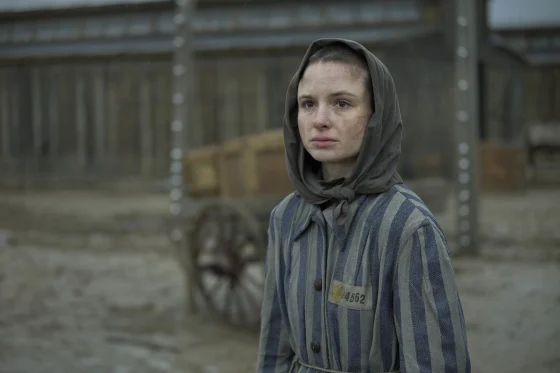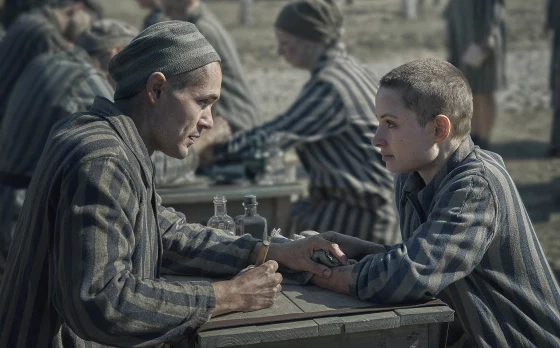Is “The Tattooist of Auschwitz” based on true events?
Is “The Tattooist of Auschwitz” based on true events?, A new television series is revisiting the compelling love story of…
Is “The Tattooist of Auschwitz” based on true events?, A new television series is revisiting the compelling love story of Lale Sokolov and Gita Furman, as depicted in the 2018 book.
Unraveling “The Tattooist of Auschwitz”: Examining the Narrative Journey from Book to TV Series
The Tattooist of Auschwitz, a poignant tale, has held audiences spellbound since its publication in 2018. Now, a television adaptation aims to retell this resounding story. But as viewers delve into this narrative, they ponder: is it a faithful depiction of true events?

The Book’s Foundation: Heather Morris’s novel, though classified as fiction, draws from the life of Lale Sokolov, a Slovakian Jew imprisoned at Auschwitz in 1942. Through Lale’s eyes, readers witness his transformation into the camp’s tattooist and his poignant romance with Gita Furman. Morris maintains that while the book isn’t an authoritative historical record, it largely aligns with Lale’s firsthand testimony.
Navigating Fact and Fiction: Morris admits to fictionalizing certain events for dramatic effect while striving to honor the essence of Lale’s story. Despite HarperCollins’ disclaimer labeling the book as fiction, Morris asserts that 95% of the narrative adheres to historical accuracy, a claim disputed by the Auschwitz Memorial Research Centre.
The TV Series: Balancing Truth and Drama Subheading 1: Addressing Discrepancies The TV adaptation grapples with the challenge of honoring Lale’s memories while crafting compelling drama. Claire Mundell, the executive producer, acknowledges the need for narrative choices, given Lale’s non-linear recollections shaped by trauma.
Is “The Tattooist of Auschwitz” based on true events?
Exploring Narrative Layers A notable departure from the book lies in the portrayal of an older Lale recounting his experiences to Heather Morris. This framing device allows for a nuanced exploration of memory, shame, and the lasting impact of trauma. Viewers witness Lale’s evolving trust in Morris, reflected in the shifting clarity of his recollections.
Drawing from Multiple Sources The TV series draws from Morris’s novel, Lale’s testimonies, and consultations with historical experts, striving to weave a narrative that resonates authentically with the complexities of Holocaust survivorship. Additionally, insights from Shoah testimonies and cultural consultants enrich the storytelling.
As viewers immerse themselves in the televised adaptation of “The Tattooist of Auschwitz,” they confront the intricate interplay between fact and fiction, trauma and resilience. Through meticulous storytelling and a commitment to honoring survivors’ experiences, the series endeavors to pay homage to a poignant chapter of history while navigating the inherent complexities of memory and narrative interpretation.
Read More: Latest News Join TELEGRAM
FAQs: Unraveling “The Tattooist of Auschwitz”: Frequently Asked Questions
Q: Is “The Tattooist of Auschwitz” a true story?
A: While classified as fiction, the book draws heavily from the life of Lale Sokolov, a Slovakian Jew who was imprisoned at Auschwitz. Author Heather Morris based the narrative on Lale’s firsthand testimony, striving to maintain historical accuracy while fictionalizing certain elements for dramatic effect.
Q: How accurate is the portrayal of events in the book?
A: Heather Morris asserts that 95% of the story aligns with Lale’s recollections, although this claim has been challenged by the Auschwitz Memorial Research Centre, citing numerous errors and inconsistencies. HarperCollins Publishers categorize the book as fiction, emphasizing its fictionalized elements alongside authentic historical details.
Q: How does the TV series compare to the book?
A: The television adaptation grapples with balancing truth and drama, acknowledging the need for narrative liberties while honoring Lale’s memories. Executive producer Claire Mundell emphasizes the series’ reliance on Lale’s account, supplemented by historical consultations and Shoah testimonies. However, the series introduces narrative devices, such as an older Lale recounting his experiences to Heather Morris, to explore the complexities of memory and trauma.
